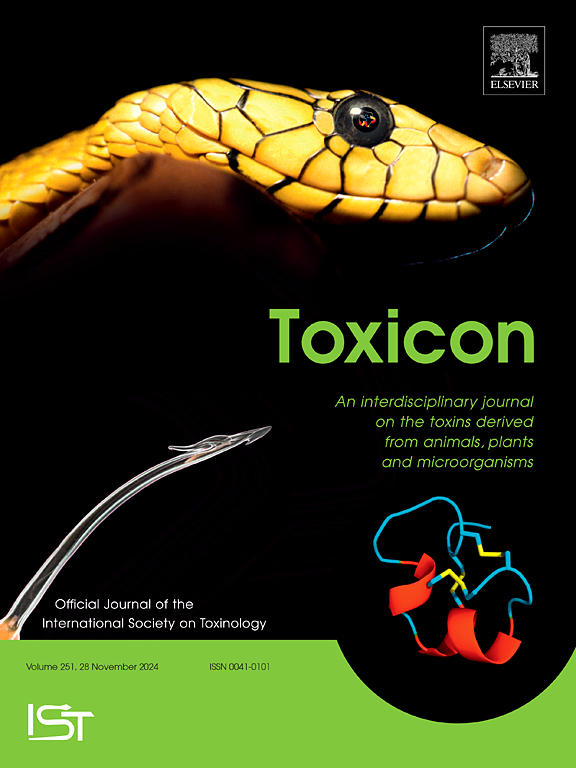印度次大陆的Kraits:自然史,风险,毒液变异,致命性和治疗策略-综合综述。
IF 2.6
4区 医学
Q2 PHARMACOLOGY & PHARMACY
引用次数: 0
摘要
世界卫生组织于2017年将“蛇咬伤”重新分类为被忽视的热带病,据估计,每年有多达540万人遭受蛇咬伤。在这大量的蛇咬伤中,大约50%的病例发生了中毒,导致的死亡人数可能高达13.8万人。该属通常被称为kraits是医学上重要的蛇,广泛分布于印度次大陆,中国南部和东南亚国家(菲律宾除外)。印度次大陆(印度、孟加拉国、不丹、尼泊尔、巴基斯坦、斯里兰卡和马尔代夫)是8-9种金环蛇的家园,其中黑螺旋体和黑螺旋体剧毒。这篇综述介绍了目前在印度次大陆对水蛭咬伤的了解状况。对印度次大陆的水蛭中毒风险、毒液致命性和管理进行了批判性分析。此外,本文还对水蚤干咬伤的防治问题进行了综述。此外,关键方面,如医护人员的蛇咬伤管理知识,蛇咬伤患者的临床症状,以及医疗机构的治疗,包括抗蛇毒血清管理及其临床疗效,帮助我们确定了关键的知识差距。拟议的预防措施将有助于减少与水蚤咬伤有关的死亡率和发病率。此外,开发和提供负担得起的治疗方案可能有助于有效管理水蚤咬伤。本文章由计算机程序翻译,如有差异,请以英文原文为准。
Kraits of Indian subcontinent: Natural history, risks, venom variation, lethality and treatment strategies – A comprehensive review
The World Health Organization (WHO) has re-classified “Snakebite” as a Neglected Tropical Disease in 2017, and estimated that as many as 5.4 million people suffer from snakebites every year. Out of this large number of snakebites, envenoming occurs in about 50 % of the cases, and the number of resulting deaths could be as high as 138,000. The genus Bungarus commonly known as kraits are medically important elapid snakes widely distributed in the Indian subcontinent, southern China and the Southeast Asian countries (except Philippines). The Indian subcontinent (India, Bangladesh, Bhutan, Nepal, Pakistan, Sri Lanka and Maldives) is home to 8–9 krait species, among which B. caeruleus and B. niger are highly venomous. This review presents the current state of knowledge on krait bites in the Indian subcontinent. The risk of envenomation by kraits, the venom lethality and krait bite management in the Indian subcontinent have been critically analyzed. Moreover, the issue of dry bites from kraits and their management has also been reviewed. Furthermore, critical aspects, such as knowledge of snakebite management among healthcare workers, clinical symptoms of snakebite patients, and treatment in healthcare facilities including antivenom administration and their clinical efficacy, have helped us in identifying the critical knowledge gaps. Proposed preventive measures will help to reduce krait bite associated mortality and morbidity. Moreover, development and accessibility to affordable treatment options may help in the effective management of krait bites.
求助全文
通过发布文献求助,成功后即可免费获取论文全文。
去求助
来源期刊

Toxicon
医学-毒理学
CiteScore
4.80
自引率
10.70%
发文量
358
审稿时长
68 days
期刊介绍:
Toxicon has an open access mirror Toxicon: X, sharing the same aims and scope, editorial team, submission system and rigorous peer review. An introductory offer Toxicon: X - full waiver of the Open Access fee.
Toxicon''s "aims and scope" are to publish:
-articles containing the results of original research on problems related to toxins derived from animals, plants and microorganisms
-papers on novel findings related to the chemical, pharmacological, toxicological, and immunological properties of natural toxins
-molecular biological studies of toxins and other genes from poisonous and venomous organisms that advance understanding of the role or function of toxins
-clinical observations on poisoning and envenoming where a new therapeutic principle has been proposed or a decidedly superior clinical result has been obtained.
-material on the use of toxins as tools in studying biological processes and material on subjects related to venom and antivenom problems.
-articles on the translational application of toxins, for example as drugs and insecticides
-epidemiological studies on envenoming or poisoning, so long as they highlight a previously unrecognised medical problem or provide insight into the prevention or medical treatment of envenoming or poisoning. Retrospective surveys of hospital records, especially those lacking species identification, will not be considered for publication. Properly designed prospective community-based surveys are strongly encouraged.
-articles describing well-known activities of venoms, such as antibacterial, anticancer, and analgesic activities of arachnid venoms, without any attempt to define the mechanism of action or purify the active component, will not be considered for publication in Toxicon.
-review articles on problems related to toxinology.
To encourage the exchange of ideas, sections of the journal may be devoted to Short Communications, Letters to the Editor and activities of the affiliated societies.
 求助内容:
求助内容: 应助结果提醒方式:
应助结果提醒方式:


